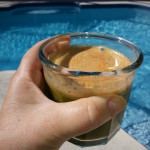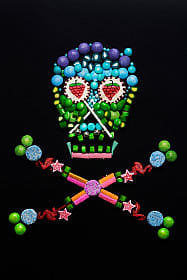weight loss
now browsing by tag
Day 11 – 30 Day Juicing Challenge

 Day 11 and here I am. Talk about persistence! Really, there were times I didn’t think I could make it this far. Yea, for me! Today, as apposed to yesterday, I am feeling a lot better. The sore throat is almost gone and I’m feeling a little more energetic today.
Day 11 and here I am. Talk about persistence! Really, there were times I didn’t think I could make it this far. Yea, for me! Today, as apposed to yesterday, I am feeling a lot better. The sore throat is almost gone and I’m feeling a little more energetic today.
With my morning juicing, I watched Joe Cross’ Fat, Sick and Nearly Dead for inspiration. I learned even more about juicing. Yes, inspired to go on! I am not juicing entirely for my meals and yesterday along with the Girl Scout cookies I had an Atkins bar and a tomato and mayo sandwich on whole wheat bread. Really, I was having an off day. Oh and I must not forget that I served for dinner Chinese food. I had a
couple of bites but it tasted awful. My husband and mother who I prepare (or fast food buy) dinner for every night LOVED the Chinese. Meaning, it is definitely my taste buds that are changing and demanding better quality of food.
I noticed in the movie that Joe Cross’ extractor has a much wider mouth on its shoot and he can cram larger veggie pieces down while mine is narrow and I have to cut the pieces into smaller sizes. It’s mostly a pain when I’m stuffing veggies down. So here are some examples of some extractor:
Now why am I using an extractor instead of a mixer? I am using the theory of Joe Cross and Dr. Mark Furhman that extracting the pulp allows the micronutrients* to be easily absorbed into your cells. That’s what I am going for; healing my body. I have autoimmune diseases, yes multiple, and I am looking at years of prescriptions unless I can heal myself. As Joe Cross points out in Fat, Sick and Nearly Dead, when you get a scrape you body can heal itself, so your body can heal itself on the inside. Okay, I’m trying that theory out by juicing.
My plea is…micronutrients please go right to my cells and make them healthy!
I want to be that same woman I was 10 years ago; a little turbo happily multitasking and socializing everyday. I want to climb Noonmark again.
Joe Cross, Australian dude as in G’day Mate!, started with a 90 day juicing personal challenge where he only juiced for 90 days….nothing else was consumed except water. Yikes! I am starting off with my own personal challenge as I pull out the extractor and make a veggie/fruit juice combo once a day. I’m getting to the point where I wouldn’t mind doing a total juicing everyday instead of any whole food, but I’ll think about that challenge after day 30.
Today’s recipe: (for 8 ounces)


- Kale
- Collard greens
- Carrot
- Apple
- Slice of ginger
- Sugar snap peas
- Orange
Day 11 done. Check!
*Micronutrients are nutrients required by humans and other organisms throughout life in small quantities to orchestrate a range of physiological functions. [1] For people, they include dietary trace minerals in amounts generally less than 100 milligrams/day – as opposed to macrominerals which are required in larger quantities. The microminerals or trace elements include at least iron, cobalt, chromium, copper, iodine, manganese, selenium, zinc and molybdenum. Micronutrients also include vitamins, which are organic compounds required as nutrients in tiny amounts by an organism.
White Poison-Sugar!
5 Clues You Are Addicted to Sugar
Most of us have felt the urge, the unstoppable craving driving us to seek out something sweet and devour it in a flash. That uncontrollable yen for cookies, cake or ice cream or that whole basket of bread calling to us to finish it off. Why do you overeat? Why does that cookie have such power over you, even though you know it will make you fat and sick? Is it an indication of your moral weakness, lack of will power, or is it a powerful hardwired brain response over which you have little control?
Debate has raged recently about whether junk food, the hyper-processed, hyper-palatable food that has become our SAD (standard American diet) is addictive in the same way that heroin or cocaine is addictive. A new study published in the American Journal of Clinical Nutrition suggests that, in fact, higher sugar, higher glycemic foods can be addictive.
David Ludwig, author of Ending the Food Fight, and his colleagues at Harvard, in a very sophisticated study, showed that foods with more sugar, foods that raise blood sugar even more than table sugar such as white flour, white potatoes and refined starch have what is called a high glycemic index, trigger a special region in the brain called the nucleus  accumbens that is known to be “ground zero” for conventional addiction, such as gambling or drug abuse.
accumbens that is known to be “ground zero” for conventional addiction, such as gambling or drug abuse.
It appears part of the reason almost 70 percent of Americans are overweight or one in two Americans has pre-diabetes or Type 2 diabetes may not be gluttony, lack of willpower or absence of personal responsibility but plain old, garden variety biological addiction.
Many previous studies have shown how this region of brain, the pleasure center, lights up in response to images or eating sugary, processed or junk food. But many of these studies used very different foods as a comparison. If you compare cheesecake to boiled vegetables, there are many reasons the pleasure center can light up. It tastes better or it looks better. This is interesting data, but it’s not hard proof of addiction.
This new study took on the hard job of proving the biology of sugar addiction. The researchers did a randomized, blinded, crossover study using the most rigorous research design to ward off any criticism (which will inevitably come from the $1 trillion food industry).
They took 12 overweight or obese men between the ages of 18 and 35 and gave each a low sugar or low glycemic index (37 percent) milkshake, and then, four hours later, they measured the activity of the brain region (nucleus accumbens) that controls addiction. They also measured blood sugar and hunger.
Then, days later, they had them back for another milkshake. But this time they switched the milkshakes. They were designed to taste exactly the same and be exactly the same in every way except in how much and how quickly it spiked blood sugar. The second milkshake was designed to be high in sugar with a high glycemic index (84 percent). The shakes had exactly the same amount of calories, protein, fat and carbohydrate. Think of it as a trick milkshake. The participants didn’t know which milkshake they were getting, and their mouth couldn’t tell the difference, but their brains could.
Each participant received a brain scan and blood tests for glucose and insulin after each version of the milkshake. They were their own control group. Without exception, they all had the same response. The high sugar or glycemic index milkshake caused a spike in blood sugar and insulin and an increase in reported hunger and cravings four hours after the shake. Remember — exactly the same calories, sweetness, texture and macronutrient content.
This finding was not surprising and has been shown many times before.
But the breakthrough finding was this: When the high glycemic shake was consumed, the nucleus accumbens lit up like a Christmas tree. This pattern occurred in every single participant and was statistically significant.
This study showed two things.
First, the body responds quite differently to different calories, even if the protein, fat and carbs (and taste) are exactly the same.
And second, foods that spike blood sugar are biologically addictive.
This game-changing study must force a shift in the conversation about obesity in America. There are 600,000 processed foods in the marketplace, 80 percent of which have added hidden sugar. The average American consumes 22 teaspoons of sugar a day, mostly hidden, and the average teenage boy has 34 teaspoons a day (more than two 20 ounce sodas). One serving of Prego tomato sauce has more sugar than a serving of Oreo cookies. Sweetened yogurts can have more sugar than a can of soda.
Sugar is the core ingredient used by the food industry to make bad ingredients (processed flour and chemicals) taste good. Our consumption has increased from 10 pounds per person in 1800 to 140 pounds per person per year today.
Each year, the average American also consumes 133 pounds of white or wheat flour, which raises blood sugar more than table sugar (sucrose).
When a 12-year-old boy needs a liver transplant after a steady diet of soda and white flour, or when a 2-year-old can’t walk because he is too fat at 50 pounds, we can no longer point to personal responsibility as the solution to our obesity epidemic.
What if Kobe Bryant or LeBron James went on national television promoting the benefits of “cocaine water” to increase sports performance? Would you allow heroin dispensers in your kid’s school? Think heroin lollipops or morphine muffins. This is exactly what’s happening in America today.
No one wants to be fat or become a drug addict. No one wants their life destroyed by disability and illness. We have policies and laws that protect people from alcohol, tobacco and illegal drugs of abuse. Sugar and flour (and too much starchy white potatoes and white rice) or products containing them appear to be no different. In fact, some animal studies show that sugar is eight times as addictive as cocaine.
It is time to stop blaming the fat person. Can we really blame our children if we freely give them drugs of abuse in the school lunch line or as after school snacks? Can we really blame the average overweight person? The nutritional landscape in America is a food carnival.
Kelly Brownell from Yale’s Rudd Center for Food Policy and Obesity has created a validated food questionnaire to help you determine if you are a food addict. He recently also published a textbook, Food and Addiction, that lays out the science of how our hyper-processed, hyper-palatable, hyper-sweet industrial food has hijacked our brain chemistry and biology.
Here are five clues you may be addicted to sugar, flour and processed food:
- You consume certain foods even if you are not hungry because of cravings.
- You worry about cutting down on certain foods.
- You feel sluggish or fatigued from overeating.
- You have health or social problems (affecting school or work) because of food issues and yet keep eating the way you do despite negative consequences.
- You need more and more of the foods you crave to experience any pleasure or reduce negative emotions.
If you are among those whose brain chemistry, taste buds and hormones have been hijacked by the food industry (up to 70 percent of us, including 40 percent of children), then it is time to stop blaming yourself and consider food rehab or a sugar detox. It is time for all of us to take back our health and demand that our children be protected from addictive substances in our schools and from the insidious marketing practices directed at them from the food industry.
There are resources to help you break your food addiction and stop the cravings.
Now, I would love to hear from you.
Have you experienced uncontrollable cravings for sugar and refined foods?
How has it affected your life?
Have you blamed yourself for your behavior?
Do you think we should change food policy to protect children from marketing of foods proven to be addictive?
To your good health,
Mark Hyman, MD
Let Go of Perfection

Prevention News
Prevention News
Why You Should Let Go Of Weight Perfection
What’s Your Ideal Weight?
What that number really means
By Tracy Miller

There’s your age. Your birthday. Your phone number. Your social security number. And then there’s that other number that’s been lurking in your head for years: Your ideal weight.
If you’re like most women, those three digits are all but tattooed in your brain—easily conjured up the moment your jeans feel snug or you step on the scale. But how did it get there in the first place? And what does it even mean? Not much, according to experts.
“A lot of women have an ‘ideal’ weight they think they’ll feel best at,” says Jessica Crandall, a registered dietitian and spokesperson for the American Academy of Nutrition and Dietetics. “Even though they’re healthy and their BMI is healthy, they still feel that pressure that can encompass their entire lives.”
Often, says Crandall, we fixate on a target weight—wanting to be 125, say, when you’re actually 135—without really knowing why. “You may have been there once early on, in your teens or early 20s, and you felt comfortable at that time,” says Crandall. “Or it might be something that a doctor once put into your head, and it just stuck there.” But chances are, it doesn’t deserve the attention you’ve been giving it.
If losing a little weight has become an oversized obsession, here’s how to divert your focus away from that number and toward more important things—you know, like the rest of your life.
Ask yourself why. “I ask clients what their goals are to help them see where they’re coming from,” says Crandall. If your ideal weight is a number you’ve been carrying around for decades because it’s what you weighed in college or at your wedding, ask yourself what’s more important—hitting that number again or how you feel from day to day? Restate for yourself the importance of a healthy balance between work, life, and concerns like diet and exercise.
Pick a new measurement. In fact, don’t just stop at one. Several different factors go into determining your individual healthy weight range, says Crandall, such as body fat composition, bone size, muscular structure, BMI, and waist circumference. A registered dietitian can properly assess the overall balance of your body and whether you really need to lose a few pounds—or need help setting more appropriate goals.
Stop the strict dieting. “There is not one food that’s going to cause you to gain weight,” says Crandall. Yet many women stick to a short list of “acceptable” foods when dieting—which can backfire. Dieters may cut out sugar, for instance, and think that means they shouldn’t eat a fresh orange, says Freytag. “Of course you should have an orange!” she adds. “It’s the added sugars in processed foods and drinks that are the problem.”
More from Prevention: Why You Shouldn’t Be a Diet Perfectionist
Don’t live at the gym. If you’ve been plugging away on the elliptical trainer with all the enthusiasm of a prisoner walking the plank, try mixing it up. “You don’t want to become obsessive with your activity,” says Crandall. “If you’ve been running and running and running, try yoga or biking.” Determine a healthy amount of time you want to devote to exercising each week, then stick to the plan.
Focus on re-sculpting. “Muscle is the secret to long-term metabolism boosting,” says Freytag. “I usually say to women, ‘Let’s forget about those five pounds and focus on re-sculpting your body.’ ” If you change your focus to being healthy, fit, and toned, a few pounds up or down won’t matter.
Published April 2012, Prevention
Why You Should Let Go Of Weight Perfection
What’s Your Ideal Weight?
By Tracy Miller

There’s your age. Your birthday. Your phone number. Your social security number. And then there’s that other number that’s been lurking in your head for years: Your ideal weight.
If you’re like most women, those three digits are all but tattooed in your brain—easily conjured up the moment your jeans feel snug or you step on the scale. But how did it get there in the first place? And what does it even mean? Not much, according to experts.
Published April 2012, Prevention



 D5 Creation
D5 Creation